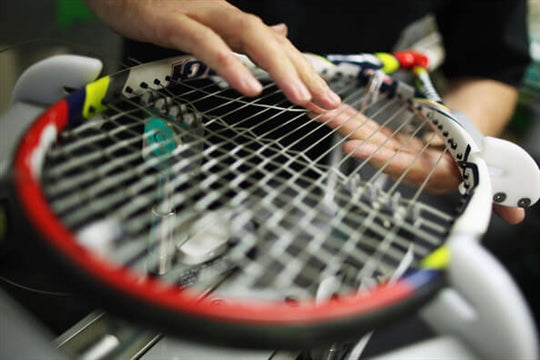One of the questions we get asked a lot is how often should I restring my racket. It's a good question, with no perfect answer.
Traditionally the simple rule was always 'Change the string as many times per year as you play per week.' So, if you play 2 times a week, every six months.
But that doesn't tell the full story.
The truth is, strings wear down with play and lose their elasticity and tension. If left unchanged for too long, they can negatively affect your performance.
And just because they didn't break doesn't mean it's not time for a restring.
So why change strings that haven't broken?
Tension Loss
Strings loose tension over time. Tension drops quickly within the first hour of play and (around 10%) then continues to drop slowly over time. After two months you've probably lost around half that tension.
As strings lose tension, you may feel that the racket is "going dead," "getting mushy" or "losing its punch."
If you take your game seriously, it's not uncommon to restring your racket every 10 to 15 hours of play - especially if you use polyester. You can add a couple more hours if you use nylon or multi-fibre string.
CALL US TO GET YOUR RACKET RESTRUNG OR LEARN MORE TODAY
Performance
As your strings lose their tension, they also lose their effect which you bought them for in the first place.
Tension is important for control. The reduction in the pull force creates a “trampoline effect” which reduces control.
When the strings stretch more, the ball stays on the strings longer. The increase is only a millisecond or two (depending on where on the racket you hit and how violent the impact, dwell time is typically 5 to 7 milliseconds).
During that extra millisecond, your racket will sweep through both a larger vertical and horizontal arc. This will launch the ball on a higher and more sideways trajectory than you are used to. The ball goes long and wide.
Change in Stroke
It has been shown that string tension has very little impact on spin. A ball fired obliquely at the same racket with different tensions rebounds at about the same spin. However, if tension goes down and you are hitting the ball deeper (too deep), your natural response will be to either hit it more softly or to add more spin. The loose strings don't cause more spin; rather, they cause you to add more spin. Again, these are usually unconscious adjustments to your strokes as your day-to-day racket performance changes. Your strings change your strokes daily. And you thought you were just having a bad day.
Comfort
A freshly strung racquet can help cut down on shock and increase comfort.
Any players suffering from tennis elbow or general arm discomfort should keep a close eye on their strings and, within reason, restring more frequently to ensure optimal health.
So What's Best?
When it comes to replacing your tennis strings, it’s important to note that different strings will do a better job maintaining their tension and resilience over time. In some cases, you may hear this referred to as tension maintenance or playability duration.
If you don't restring often enough, chances are you'll spend much of your tennis life compensating for your changing string tension instead of honing your swing. Consistency is the key.

